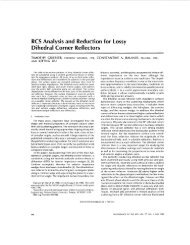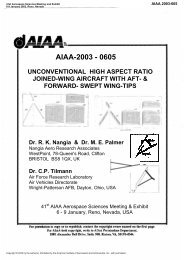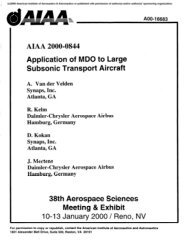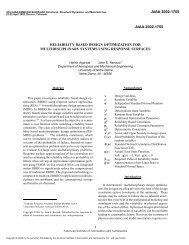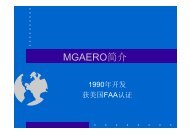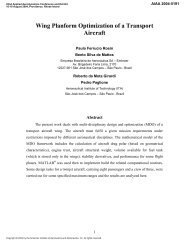The design report
The design report
The design report
Create successful ePaper yourself
Turn your PDF publications into a flip-book with our unique Google optimized e-Paper software.
When the skeleton of the fuselage was ready, the balsa skin was ready to be placed on it.<br />
1.5mm balsa sheet was used as the skin of the fuselage there was no 1mm balsa sheet<br />
available. To prevent the balsa sheet from cracking, they had to be placed or submerged<br />
in water first. <strong>The</strong> balsa in water technique worked great on the fuselage as we had a<br />
circular fuselage. It would be really difficult to bend the balsa sheet if it was just a dry<br />
sheet. After bending the fuselage into shape, the balsa is left to dry up and take the<br />
shape of the fuselage, and then we stick it on. We deliberately left two major parts of the<br />
balsa not completely stuck onto the fuselage as we wanted to have an easy access into<br />
the fuselage for maintenance purposes. <strong>The</strong> whole top part before the top plate was left<br />
open with a balsa sheet acting as a door and half of the side of the fuselage under the<br />
wing was left open as they are the most crucial part of the <strong>design</strong> and requires high<br />
maintenance.<br />
After all the balsa skin was done, thermal shrink films were ironed on top of the balsa<br />
skin for finishing touch.<br />
Wing fabrication 5.3<br />
Wing fabrication was started by cutting all parts (ribs, spars, webs, rods etc.) and<br />
labelling them. Once all the required parts were cut and collected, the process of<br />
sticking everything together was started. AB glue was used for most of wing structure<br />
however superglue was occasionally used. A total of 5 webspars were used and firstly<br />
all the ribs were glued and locked in. Webspars ensured that the ribs couldn’t move in<br />
any direction. <strong>The</strong> only problem was that the wood used was not perfectly straight<br />
which meant that some ribs and webspars had a bend in them. <strong>The</strong> bending was<br />
corrected once all rods and spars were glued on. After the webspars, spar caps at 30%<br />
at top and bottom of the ribs were glued on. <strong>The</strong> sparcaps run through most of the wing<br />
structure which meant that 2 rods had to be joined due to lack of availability of longer<br />
rods. After this, front spar was glued on and it was also done by joining 2 pieces.<br />
Figure 5.3.101








![Introduction to RF Stealth [Book Review] - Antennas and ...](https://img.yumpu.com/16857890/1/190x245/introduction-to-rf-stealth-book-review-antennas-and-.jpg?quality=85)

